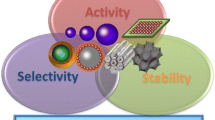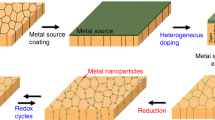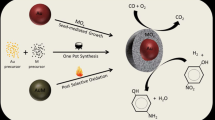Abstract
Noble metal nanoclusters, as a bridge between atoms and nanoparticles, show extraordinary catalytic activities because of their unique electronic structures. Such nanoclusters are usually synthesized by a wet chemical approach through unfavorable surface passivation by ligands and have not been obtained by an impregnation approach with satisfactory size uniformity. Herein, we report highly uniform ligand-free noble metal nanoclusters, such as Pd nanoclusters, synthesized each in a silica capsule by an impregnation strategy, with their size accurately engineerable in the range of 0.9–2.9 nm. The key is to ensure the impregnation synthesis with strict control over the nucleation and growth of noble metal nanoclusters by involving hollow silica nanoreactors and non-noble metal competitor ions, thereby showing unprecedented advantages of operational simplicity, scalability, and excellent size controllability. These Pd nanoclusters exhibit a strong size effect on catalysis exemplified by the alcohol oxidation-Knoevenagel condensation sequential reaction, with those of 1.3 nm exhibiting the highest catalytic activity. We believe this novel strategy opens new opportunities for rationally designing efficient noble metal nanocluster-type catalysts for a broad range of important reactions and bringing laboratory-quality nanoclusters into large-scale applications.

摘要
贵金属纳米团簇作为原子和纳米颗粒的中间形态, 表现出特殊 的电子结构和优异的催化性能. 目前, 这类纳米团簇通常通过湿化学法 合成, 其表面常被配体所钝化, 而通过浸渍法合成的贵金属纳米团簇通 常表现出较宽的尺寸分布. 本研究以钯为例, 发展了基于浸渍法精准合 成尺寸介于0.9和2.9 nm、无表面配体的贵金属纳米团簇的新范式. 该 方法关键在于采用二氧化硅纳米胶囊为纳米反应器并引入非贵金属竞 争吸附离子, 从而达到严格控制贵金属纳米团簇成核和生长的目的, 因 此具有操作便利、合成可放大及纳米团簇尺寸精准可调等优势. 钯纳 米团簇在醇氧化-Knoevenagel缩合连续反应中表现出显著的尺寸效应, 其中1.3 nm的钯纳米团簇具有最优的催化活性. 这一新颖的合成策略 为贵金属纳米团簇型催化剂的开发提供了新思路, 为实验室级高品质 纳米团簇催化剂的规模应用提供了可行方案.
Similar content being viewed by others
References
Yan J, Teo BK, Zheng N. Surface chemistry of atomically precise coinage-metal nanoclusters: From structural control to surface reactivity and catalysis. Acc Chem Res, 2018, 51: 3084–3093
Gao C, Lyu F, Yin Y. Encapsulated metal nanoparticles for catalysis. Chem Rev, 2021, 121: 834–881
Chen X, Peng M, Cai X, et al. Regulating coordination number in atomically dispersed Pt species on defect-rich graphene for n-butane dehydrogenation reaction. Nat Commun, 2021, 12: 2664
Wang L, Diao J, Peng M, et al. Cooperative sites in fully exposed Pd clusters for low-temperature direct dehydrogenation reaction. ACS Catal, 2021, 11: 11469–11477
Liu M, Liu M, Wang X, et al. Quantum-dot-derived catalysts for CO2 reduction reaction. Joule, 2019, 3: 1703–1718
Kuhn JN, Huang W, Tsung CK, et al. Structure sensitivity of carbon-nitrogen ring opening: Impact of platinum particle size from below 1 to 5 nm upon pyrrole hydrogenation product selectivity over mono-disperse platinum nanoparticles loaded onto mesoporous silica. J Am Chem Soc, 2008, 130: 14026–14027
Yamamoto K, Imaoka T, Chun WJ, et al. Size-specific catalytic activity of platinum clusters enhances oxygen reduction reactions. Nat Chem, 2009, 1: 397–402
Bai L, Wang X, Chen Q, et al. Explaining the size dependence in platinum-nanoparticle-catalyzed hydrogenation reactions. Angew Chem Int Ed, 2016, 55: 15656–15661
Wang H, Gu XK, Zheng X, et al. Disentangling the size-dependent geometric and electronic effects of palladium nanocatalysts beyond selectivity. Sci Adv, 2019, 5: eaat6413
Guan Q, Zhu C, Lin Y, et al. Bimetallic monolayer catalyst breaks the activity-selectivity trade-off on metal particle size for efficient chemo-selective hydrogenations. Nat Catal, 2021, 4: 840–849
Mistry H, Reske R, Zeng Z, et al. Exceptional size-dependent activity enhancement in the electroreduction of CO2 over Au nanoparticles. J Am Chem Soc, 2014, 136: 16473–16476
Liu Y, Tsunoyama H, Akita T, et al. Aerobic oxidation of cyclohexane catalyzed by size-controlled Au clusters on hydroxyapatite: Size effect in the sub-2 nm regime. ACS Catal, 2010, 1: 2–6
Li G, Jin R. Gold nanocluster-catalyzed semihydrogenation: A unique activation pathway for terminal alkynes. J Am Chem Soc, 2014, 136: 11347–11354
Li G, Jiang D, Kumar S, et al. Size dependence of atomically precise gold nanoclusters in chemoselective hydrogenation and active site structure. ACS Catal, 2014, 4: 2463–2469
Bai L, Zhang S, Chen Q, et al. Synthesis of ultrasmall platinum nanoparticles on polymer nanoshells for size-dependent catalytic oxidation reactions. ACS Appl Mater Interfaces, 2017, 9: 9710–9717
Zhao H, Yao S, Zhang M, et al. Ultra-small platinum nanoparticles encapsulated in sub-50 nm hollow titania nanospheres for low-temperature water-gas shift reaction. ACS Appl Mater Interfaces, 2018, 10: 36954–36960
Yao Q, Chen T, Yuan X, et al. Toward total synthesis of thiolate-protected metal nanoclusters. Acc Chem Res, 2018, 51: 1338–1348
Chakraborty I, Pradeep T. Atomically precise clusters of noble metals: Emerging link between atoms and nanoparticles. Chem Rev, 2017, 117: 8208–8271
Jin R, Zeng C, Zhou M, et al. Atomically precise colloidal metal nanoclusters and nanoparticles: Fundamentals and opportunities. Chem Rev, 2016, 116: 10346–10413
Yamamoto K, Imaoka T, Tanabe M, et al. New horizon of nanoparticle and cluster catalysis with dendrimers. Chem Rev, 2019, 120: 1397–1437
Ye R, Zhukhovitskiy AV, Kazantsev RV, et al. Supported Au nanoparticles with N-heterocyclic carbene ligands as active and stable heterogeneous catalysts for lactonization. J Am Chem Soc, 2018, 140: 4144–4149
Deraedt C, Ye R, Ralston WT, et al. Dendrimer-stabilized metal nanoparticles as efficient catalysts for reversible dehydrogenation/hydrogenation of N-heterocycles. J Am Chem Soc, 2017, 139: 18084–18092
Sun N, Wang C, Wang H, et al. Multifunctional tubular organic cage-supported ultrafine palladium nanoparticles for sequential catalysis. Angew Chem Int Ed, 2019, 58: 18011–18016
Yang X, Sun JK, Kitta M, et al. Encapsulating highly catalytically active metal nanoclusters inside porous organic cages. Nat Catal, 2018, 1: 214–220
Fang Y, Xiao Z, Li J, et al. Formation of a highly reactive cobalt nanocluster crystal within a highly negatively charged porous coordination cage. Angew Chem Int Ed, 2018, 57: 5283–5287
Mondal B, Acharyya K, Howlader P, et al. Molecular cage impregnated palladium nanoparticles: Efficient, additive-free heterogeneous catalysts for cyanation of aryl halides. J Am Chem Soc, 2016, 138: 1709–1716
McCaffrey R, Long H, Jin Y, et al. Template synthesis of gold nanoparticles with an organic molecular cage. J Am Chem Soc, 2014, 136: 1782–1785
Zhao H, Wang D, Gao C, et al. Ultrafine platinum/iron oxide nanoconjugates confined in silica nanoshells for highly durable catalytic oxidation. J Mater Chem A, 2016, 4: 1366–1372
Zhang T, Zhao H, He S, et al. Unconventional route to encapsulated ultrasmall gold nanoparticles for high-temperature catalysis. ACS Nano, 2014, 8: 7297–7304
Lu L, Zou S, Fang B. The critical impacts of ligands on heterogeneous nanocatalysis: A review. ACS Catal, 2021, 11: 6020–6058
Bryant K, West CW, Saunders SR. Impacts of calcination on surface-clean supported nanoparticle catalysts. Appl Catal A-Gen, 2019, 579: 58–64
Donoeva B, de Jongh PE. Colloidal Au catalyst preparation: Selective removal of polyvinylpyrrolidone from active Au sites. ChemCatChem, 2018, 10: 989–997
Fan Q, Liu K, Liu Z, et al. A ligand-exchange route to nobel metal nanocrystals with a clean surface for enhanced optical and catalytic properties. Part Part Syst Charact, 2017, 34: 1700075
Geus JW, van Dillen AJ. Supported catalysts. In: Ertl G, Knözinger H, Schüth F, Weitkamp J (Eds.). Handbook of Heterogeneous Catalysis. Weinheim: Wiley-VCH, 2008. 428–655
Munnik P, de Jongh PE, de Jong KP. Recent developments in the synthesis of supported catalysts. Chem Rev, 2015, 115: 6687–6718
Wang N, Sun Q, Zhang T, et al. Impregnating subnanometer metallic nanocatalysts into self-pillared zeolite nanosheets. J Am Chem Soc, 2021, 143: 6905–6914
Kou Y, Sun LB. Size regulation of platinum nanoparticles by using confined spaces for the low-temperature oxidation of ethylene. Inorg Chem, 2018, 57: 1645–1650
Shi LY, Li YX, Xue DM, et al. Facile fabrication of small-sized palladium nanoparticles in nanoconfined spaces for low-temperature CO oxidation. Ind Eng Chem Res, 2020, 59: 19145–19152
Gao C, Lu Z, Yin Y. Gram-scale synthesis of silica nanotubes with controlled aspect ratios by templating of nickel-hydrazine complex nanorods. Langmuir, 2011, 27: 12201–12208
Gao C, Zhang Q, Lu Z, et al. Templated synthesis of metal nanorods in silica nanotubes. J Am Chem Soc, 2011, 133: 19706–19709
Haynes WM. CRC Handbook of Chemistry and Physics. Boca Raton: CRC Press, 2017
Wang H, Wang Y, Zhu Z, et al. Influence of size-induced oxidation state of platinum nanoparticles on selectivity and activity in catalytic methanol oxidation in the gas phase. Nano Lett, 2013, 13: 2976–2979
Sun Y, Zhuang L, Lu J, et al. Collapse in crystalline structure and decline in catalytic activity of Pt nanoparticles on reducing particle size to 1 nm. J Am Chem Soc, 2007, 129: 15465–15467
Hu Y, Zhang Q, Goebl J, et al. Control over the permeation of silica nanoshells by surface-protected etching with water. Phys Chem Chem Phys, 2010, 12: 11836–11842
Li YA, Yang S, Liu QK, et al. Pd(0)@UiO-68-AP: Chelation-directed bifunctional heterogeneous catalyst for stepwise organic transformations. Chem Commun, 2016, 52: 6517–6520
Cao CC, Chen CX, Wei ZW, et al. Catalysis through dynamic spacer installation of multivariate functionalities in metal-organic frameworks. J Am Chem Soc, 2019, 141: 2589–2593
Sun Q, Aguila B, Ma S. A bifunctional covalent organic framework as an efficient platform for cascade catalysis. Mater Chem Front, 2017, 1: 1310–1316
Feng D, Dong Y, Zhang L, et al. Holey lamellar high-entropy oxide as an ultra-high-activity heterogeneous catalyst for solvent-free aerobic oxidation of benzyl alcohol. Angew Chem Int Ed, 2020, 59: 19503–19509
Lackmann A, Mahr C, Schowalter M, et al. A comparative study of alcohol oxidation over nanoporous gold in gas and liquid phase. J Catal, 2017, 353: 99–106
Meher S, Rana RK. A rational design of a Pd-based catalyst with a metal-metal oxide interface influencing molecular oxygen in the aerobic oxidation of alcohols. Green Chem, 2019, 21: 2494–2503
Wei Q, Yu C, Song X, et al. Recognition of water-induced effects toward enhanced interaction between catalyst and reactant in alcohol oxidation. J Am Chem Soc, 2021, 143: 6071–6078
Xin P, Li J, Xiong Y, et al. Revealing the active species for aerobic alcohol oxidation by using uniform supported palladium catalysts. Angew Chem Int Ed, 2018, 57: 4642–4646
Zhu L, Lin Y, Liu K, et al. Tuning the intermediate reaction barriers by a CuPd catalyst to improve the selectivity of CO2 electroreduction to C2 products. Chin J Catal, 2021, 42: 1500–1508
Hostetler MJ, Wingate JE, Zhong CJ, et al. Alkanethiolate gold cluster molecules with core diameters from 1.5 to 5.2 nm: Core and monolayer properties as a function of core size. Langmuir, 1998, 14: 17–30
Marbella LE, Andolina CM, Smith AM, et al. Gold-cobalt nanoparticle alloys exhibiting tunable compositions, near-infrared emission, and high T2 relaxivity. Adv Funct Mater, 2014, 24: 6532–6539
Marbella LE, Millstone JE. NMR techniques for noble metal nanoparticles. Chem Mater, 2015, 27: 2721–2739
Terrill RH, Postlethwaite TA, Chen C, et al. Monolayers in three dimensions: NMR, SAXS, thermal, and electron hopping studies of alkanethiol stabilized gold clusters. J Am Chem Soc, 1995, 117: 12537–12548
Nørskov JK, Abild-Pedersen F, Studt F, et al. Density functional theory in surface chemistry and catalysis. Proc Natl Acad Sci USA, 2011, 108: 937–943
Nørskov JK, Bligaard T, Rossmeisl J, et al. Towards the computational design of solid catalysts. Nat Chem, 2009, 1: 37–46
Kalhara Gunasooriya GTK, Saeys M. CO adsorption site preference on platinum: Charge is the essence. ACS Catal, 2018, 8: 3770–3774
Xu W, Zhang M, Ma C, et al. Amorphous NiSb2O6−x nanofiber: A d-/p-block Janus electrocatalyst toward efficient NH3 synthesis through boosted N2 adsorption and activation. Appl Catal B-Environ, 2022, 308: 121225
Lin G, Ju Q, Guo X, et al. Intrinsic electron localization of metastable MoS2 boosts electrocatalytic nitrogen reduction to ammonia. Adv Mater, 2021, 33: 2007509
Acknowledgements
This work was supported by the National Natural Science Foundation of China (22071191), the Key Research and Development Projects of Shaanxi Province (2021GXLH-Z-022), the Fundamental Research Funds for the Central Universities, and the Key Scientific and Technological Innovation Team of Shaanxi Province (2020TD-001). Liu K acknowledges China Postdoctoral Science Foundation (2019TQ0249) and the Natural Science Basic Research Plan in Shaanxi Province (2022JQ-100). The authors thank the Instrument Analysis Center of Xi’an Jiaotong University for the assistance with HRTEM and XPS measurements.
Author information
Authors and Affiliations
Contributions
Gao C conceived the idea and supervised the project. Wen Z conducted the synthesis, characterization, and catalysis. Zhang S, Liu Z, Zhang Z, Qiao Z, and Liu K assisted in materials characterizations. Wen Z and Gao C wrote the manuscript. All authors discussed the results and revised the manuscript.
Corresponding author
Additional information
Zhibin Wen received his BS degree from the Northwest A&F University in 2016 and then obtained his MS degree from the Southwest University in 2019. He is currently a PhD candidate at the Frontier Institute of Science and Technology, Xi’an Jiaotong University. His research interest is the synthesis of noble metal nanoclusters for catalysis.
Chuanbo Gao received his PhD degree in applied chemistry in 2009 from Shanghai Jiao Tong University and carried out his postdoctoral research at the University of California, Riverside. Since 2012 he has been a professor at the Frontier Institute of Science and Technology, Xi’an Jiaotong University. His research interest is the precision synthesis of noble metal-based nanomaterials for catalysis and energy conversion.
Conflict of interest
The authors declare that they have no conflict of interest.
Supplementary information
Experimental details and supporting data are available in the online version of the paper.
Rights and permissions
About this article
Cite this article
Wen, Z., Zhang, S., Liu, Z. et al. Size-engineered noble metal nanoclusters synthesized by impregnation for size-dependent catalysis. Sci. China Mater. 66, 1417–1426 (2023). https://doi.org/10.1007/s40843-022-2247-0
Received:
Accepted:
Published:
Issue Date:
DOI: https://doi.org/10.1007/s40843-022-2247-0




